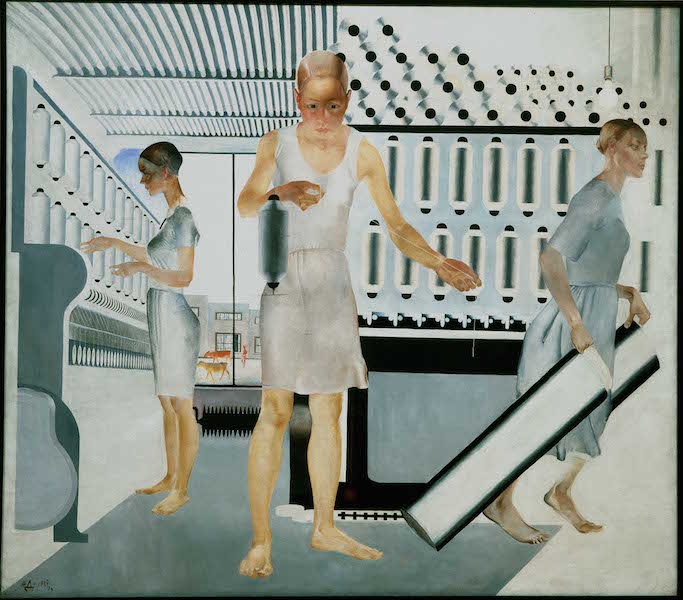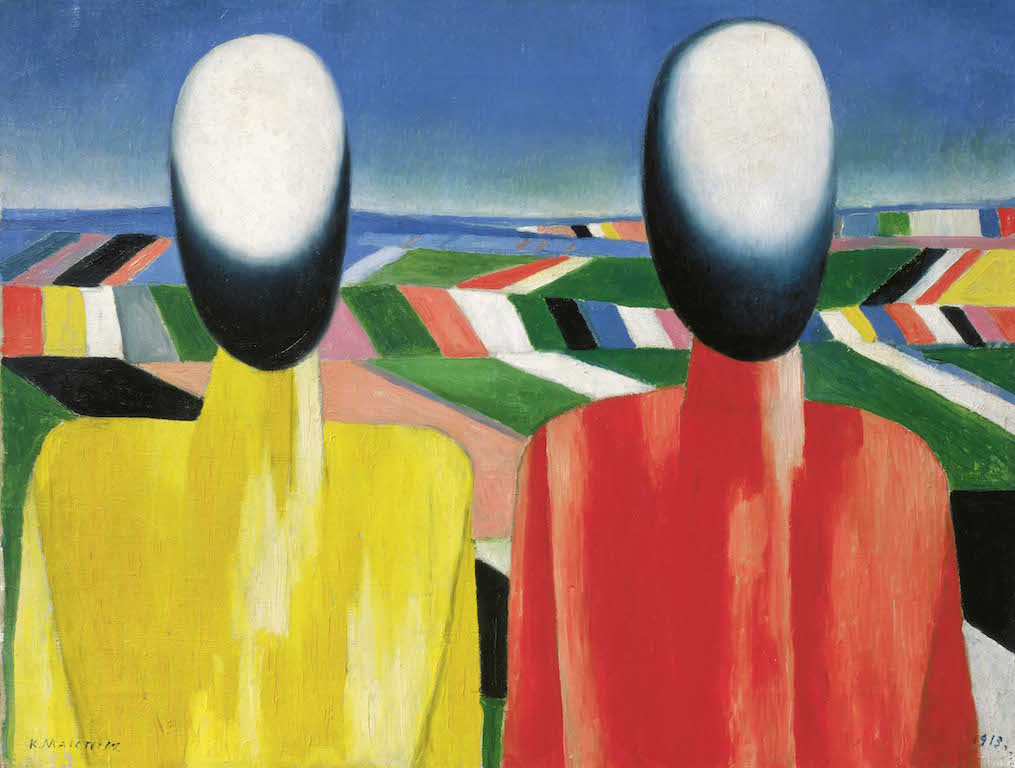Revolution: Russian Art 1917-1932, Royal Academy | reviews, news & interviews
Revolution: Russian Art 1917-1932, Royal Academy
Revolution: Russian Art 1917-1932, Royal Academy
An exhibition of Russian art purged of the artists who promoted the revolution

This must be the most depressing exhibition I have ever seen. Dedicated to the leaders of the Russian Revolution, the first room features official portraits by Isaak Brodsky of Lenin and Stalin plus drawings and models of Lenin’s vast mausoleum in Moscow’s Red Square.
But no, the second gallery is dedicated to paintings, photographs and film glorifying the workers who sweated blood in factories and fields to bring to fruition the hopelessly unrealistic plans of their successive leaders. This is propaganda at its most leaden; on canvas we see tractors gleaming in anticipation of the difference they will make to agricultural output, while on film we watch steel workers manipulating huge lengths of white hot iron to a sound track of cheering crowds.
 In a painting by Alexander Deineka (pictured right, Textile Workers, 1927) three young women operate the looms in a light and airy textile factory; they look more like healthy athletes than production line drones. The role of tendentious images like these was to divert people’s attention from dismal reality; denied the right to negotiate or strike, workers slaved away for a pittance often in dangerous conditions. Millions had been killed in the civil war and millions more would starve to death in the social and economic chaos that followed, or would be arrested on trumped up charges, tortured and summarily shot or sent to the gulag. In the next room hang photographs of the many cultural luminaries, such as the poet and playwright Vladimir Mayakovsky and theatre director Vsevolod Meyerhold, who were exiled, murdered or driven to suicide by the regime.
In a painting by Alexander Deineka (pictured right, Textile Workers, 1927) three young women operate the looms in a light and airy textile factory; they look more like healthy athletes than production line drones. The role of tendentious images like these was to divert people’s attention from dismal reality; denied the right to negotiate or strike, workers slaved away for a pittance often in dangerous conditions. Millions had been killed in the civil war and millions more would starve to death in the social and economic chaos that followed, or would be arrested on trumped up charges, tortured and summarily shot or sent to the gulag. In the next room hang photographs of the many cultural luminaries, such as the poet and playwright Vladimir Mayakovsky and theatre director Vsevolod Meyerhold, who were exiled, murdered or driven to suicide by the regime.
One of the few uplifting images in the show celebrates the harmony between man and machine. A handsome youth stands atop a giant array of well-oiled cogs. Like the paintings and film, Arkady Shaiket’s photograph delivers a package of subliminal messages. Turning a huge wheel, the heroic lad is the driver of industrial progress – the human element controlling the vast machinery of Russia’s great leap forward. Yet although obviously posed, the photograph is believable enough to transcend its remit as blatant propaganda.
Under the Tsar, artists like Wassily Kandinsky, Kazimir Malevich and Lyubov Popova had already been exploring the language of abstraction and, inspired by political idealism, after the revolution they left their studios to galvanise support for Lenin and the new regime. But the incredible outpouring of creative genius sparked by this revolutionary fervour is scarcely visible in the exhibition. There’s no mention of the agitprop trains that criss-crossed the country bearing artists and actors who promoted the revolution by performing plays and disseminating the banners, posters and pamphlets which they designed and printed in transit.
 There’s no mention of the decorations put up in the streets and squares of Kiev and Odessa for subsequent Revolution Festivities by artists like Aleksandra Ekster. There’s no trace of the experimental theatre productions staged by Meyerhold or the costumes and sets designed for them by Popova and Varvara Stepanova, nor the worker’s clothing they designed and the books they illustrated. Precious few of the experimental paintings, graphics, photographs and montages for which El Lissitzky and Alexander Rodchenko are internationally famous are included in the show and, despite being powerful images, Kandinsky and Popova’s paintings seem to be drowning in a sea of mediocrity (pictured above left: Blue Crest, 1917, by Wassily Kandinsky).
There’s no mention of the decorations put up in the streets and squares of Kiev and Odessa for subsequent Revolution Festivities by artists like Aleksandra Ekster. There’s no trace of the experimental theatre productions staged by Meyerhold or the costumes and sets designed for them by Popova and Varvara Stepanova, nor the worker’s clothing they designed and the books they illustrated. Precious few of the experimental paintings, graphics, photographs and montages for which El Lissitzky and Alexander Rodchenko are internationally famous are included in the show and, despite being powerful images, Kandinsky and Popova’s paintings seem to be drowning in a sea of mediocrity (pictured above left: Blue Crest, 1917, by Wassily Kandinsky).
On the other hand, Malevich is accorded a room of his own. This ought to redress the balance, yet does exactly the opposite. The isolation makes his dynamic Suprematist abstractions seem totally irrelevant – the product of someone locked away in a studio out of touch with reality. Nothing could be further from the truth; even before the Revolution, he and members of his Supremus group worked closely with a peasant co-operative that was set up to produce carpets, shawls and other functional items in the village of Vitebsk in Belarus, where he later taught.
Lenin had been notoriously dubious about the value of art. “Art for me is just an appendage”, he once said. “And when its use as propaganda – which we need at the moment – is over, we’ll cut it out as useless: snip, snip.” The backlash against the avant-garde artists who had done so much to further the revolution did not come, though, until after his death in 1924. Malevich, meanwhile, had been appointed director of the Petrograd State Institute of Artistic Culture, but in 1926 the institute was denounced as counter revolutionary and forced to close.  By this time, the Socialist Realism that dominates the first two rooms of the exhibition was being heavily promoted; many of Malevich’s paintings were confiscated and, banned from making any further abstractions, he began producing hideously stilted images of peasants with featureless heads and bodies simplified into geometric forms (pictured above: Peasants, 1930).
By this time, the Socialist Realism that dominates the first two rooms of the exhibition was being heavily promoted; many of Malevich’s paintings were confiscated and, banned from making any further abstractions, he began producing hideously stilted images of peasants with featureless heads and bodies simplified into geometric forms (pictured above: Peasants, 1930).
In 1932 under Stalin, an Artist’s Union was set up to impose Socialist Realism as the only acceptable style, and the repression began in ernest of anyone who did not conform. The last room of the exhibition is dominated by a booth showing mug shots of some of the victims of Stalin’s purges. These silent witnesses give the lie to the utopian propaganda being churned out by the official artists of the regime. And 100 years on, it seems that the contribution made by Russia’s avant-garde artists to the revolutionary cause is still being denied and the deadening mediocrity of Socialist Realism is still being overlooked.
rating
Share this article
Add comment
The future of Arts Journalism
You can stop theartsdesk.com closing!
We urgently need financing to survive. Our fundraising drive has thus far raised £49,000 but we need to reach £100,000 or we will be forced to close. Please contribute here: https://gofund.me/c3f6033d
And if you can forward this information to anyone who might assist, we’d be grateful.

Subscribe to theartsdesk.com
Thank you for continuing to read our work on theartsdesk.com. For unlimited access to every article in its entirety, including our archive of more than 15,000 pieces, we're asking for £5 per month or £40 per year. We feel it's a very good deal, and hope you do too.
To take a subscription now simply click here.
And if you're looking for that extra gift for a friend or family member, why not treat them to a theartsdesk.com gift subscription?
more Visual arts
 'We are bowled over!' Thank you for your messages of love and support
Much-appreciated words of commendation from readers and the cultural community
'We are bowled over!' Thank you for your messages of love and support
Much-appreciated words of commendation from readers and the cultural community
 Lee Miller, Tate Britain review - an extraordinary career that remains an enigma
Fashion photographer, artist or war reporter; will the real Lee Miller please step forward?
Lee Miller, Tate Britain review - an extraordinary career that remains an enigma
Fashion photographer, artist or war reporter; will the real Lee Miller please step forward?
 Kerry James Marshall: The Histories, Royal Academy review - a triumphant celebration of blackness
Room after room of glorious paintings
Kerry James Marshall: The Histories, Royal Academy review - a triumphant celebration of blackness
Room after room of glorious paintings
 Folkestone Triennial 2025 - landscape, seascape, art lovers' escape
Locally rooted festival brings home many but not all global concerns
Folkestone Triennial 2025 - landscape, seascape, art lovers' escape
Locally rooted festival brings home many but not all global concerns
 Sir Brian Clarke (1953-2025) - a personal tribute
Remembering an artist with a gift for the transcendent
Sir Brian Clarke (1953-2025) - a personal tribute
Remembering an artist with a gift for the transcendent
 Emily Kam Kngwarray, Tate Modern review - glimpses of another world
Pictures that are an affirmation of belonging
Emily Kam Kngwarray, Tate Modern review - glimpses of another world
Pictures that are an affirmation of belonging
 Kiefer / Van Gogh, Royal Academy review - a pairing of opposites
Small scale intensity meets large scale melodrama
Kiefer / Van Gogh, Royal Academy review - a pairing of opposites
Small scale intensity meets large scale melodrama
 Jenny Saville: The Anatomy of Painting, National Portrait Gallery review - a protégé losing her way
A brilliant painter in search of a worthwhile subject
Jenny Saville: The Anatomy of Painting, National Portrait Gallery review - a protégé losing her way
A brilliant painter in search of a worthwhile subject
 Abstract Erotic, Courtauld Gallery review - sculpture that is sensuous, funny and subversive
Testing the boundaries of good taste, and winning
Abstract Erotic, Courtauld Gallery review - sculpture that is sensuous, funny and subversive
Testing the boundaries of good taste, and winning
 Edward Burra, Tate Britain review - watercolour made mainstream
Social satire with a nasty bite
Edward Burra, Tate Britain review - watercolour made mainstream
Social satire with a nasty bite
 Ithell Colquhoun, Tate Britain review - revelations of a weird and wonderful world
Emanations from the unconscious
Ithell Colquhoun, Tate Britain review - revelations of a weird and wonderful world
Emanations from the unconscious
 Rachel Jones: Gated Canyons, Dulwich Picture Gallery review - teeth with a real bite
Mouths have never looked so good
Rachel Jones: Gated Canyons, Dulwich Picture Gallery review - teeth with a real bite
Mouths have never looked so good

Comments
Well, this is one way of
I'm glad you found something
Thank you artsdesk! Once
Thank you for your kind words
I share your thoughts
At last I've seen a review
I'm glad you found something
Sarah, I would be interested
I haven't seen the film yet
I saw it and felt about it
Best were Kandinsky and
Surely not the Maleviches of
The Malevich's were one
I was so relieved to read